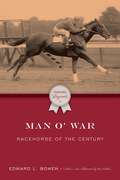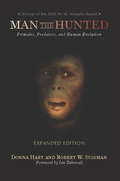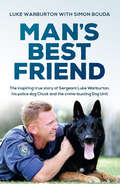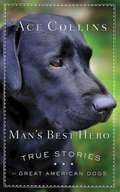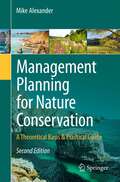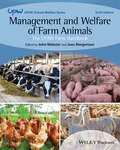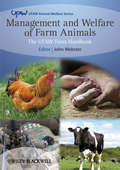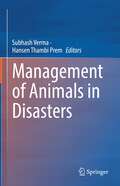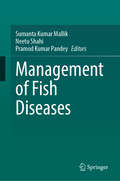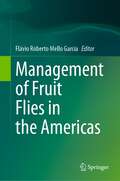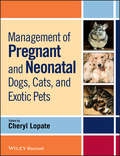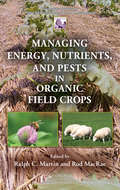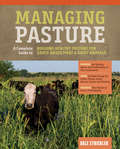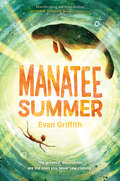- Table View
- List View
Man o' War: Racehorse of the Century (Thoroughbred Legends)
by Edward L. BowenMan o&’ War has been acclaimed as the greatest racehorse of all time, and nearly three-quarters of a century after his death his legend continues to grow. In Man o&’ War, veteran racing historian Edward L. Bowen recounts the life and times of &“Big Red.&”Bowen traces not only Man o&’ War&’s life but also those of the people connected to him—his breeder, August Belmont II; his trainer, Louis Feustel; and his famed owner, Samuel D. Riddle—weaving their stories into that of the great horse.Man o&’ War became the greatest sports hero of his era, mentioned with the same reverence as Babe Ruth, Jack Dempsey, and Red Grange. Man o&’ War&’s legend began at age two when he won nine of ten starts. Due to his great popularity, his only loss was surrounded by rumor and intrigue. Man o&’ War never knew defeat again. He dominated his rivals at every turn, even winning one race by a recorded 100 lengths.Retired to stud in Kentucky, Man o&’ War welcomed tens of thousands of fans to Faraway Farms where faithful groom Will Harbut would regale visitors with tales of Man o&’ War&’s exploits. The sons and daughters of Man o&’ War—including Triple Crown winner War Admiral—and their descendants carry on his legend in the Thoroughbred breed today.This edition includes a new afterword by the author.
Man the Hunted
by Robert W. Sussman Donna HartMan the Hunted argues that primates, including the earliest members of the human family, have evolved as the prey of any number of predators, including wild cats and dogs, hyenas, snakes, crocodiles, and even birds. The authors' studies of predators on monkeys and apes are supplemented here with the observations of naturalists in the field and revealing interpretations of the fossil record. Eyewitness accounts of the "man the hunted" drama being played out even now give vivid evidence of its prehistoric significance.This provocative view of human evolution suggests that countless adaptations that have allowed our species to survive-from larger brains to speech-stem from a considerably more vulnerable position on the food chain than we might like to imagine. The myth of early humans as fearless hunters dominating the earth obscures our origins as just one of many species that had to be cautious, depend on other group members, communicate danger, and come to terms with being merely one cog in the complex cycle of life.The expanded edition includes a new chapter that describes the ever-increasing evidence of predation on humans and other primates and claims that the earliest humans were neither hunters nor even the accomplished scavengers that many authorities have claimed.ContentsForeword by Ian Tattersall1. Just Another Item on the Menu2. Debunking "Man the Hunter"3. Who's Eating Whom?4. Lions and Tigers and Bears, Oh My!5. Coursing Hyenas and Hungry Dogs6. Missionary Position7. Terror from the Sky8. We Weren't Just Waiting Around to be Eaten!9. Gentle Savage or Bloodthirsty Brute?10. Man the Hunted11. The Final Word
Man the Hunted
by HartAlthough "Man the Hunter” is a popular description of our ancestry, the central importance of hunting is firmly fixed only in the archeological record of relatively recent human history. Man the Huntedargues that primates, including the earliest members of the human family, have evolved not as hunters but as the prey of any number of predators, including wild cats and dogs, hyenas, snakes, crocodiles, and even birds of prey. Eyewitness accounts, data collected by the authors, and the published reports of naturalists establish the astonishing extent to which living monkeys, lemurs, apes, and even humans fall victim to a wide variety of predators, some of which even specialize in the consumption of primates. Additionally, the fossil record demonstrates that primates have been prey for millions of years, a fact that necessarily shaped the evolution of our earliest ancestors in body and behavior. Skillfully combining information from a number of lines of evidence,Man the Huntedcasts an entirely new light on the natural history of primates and the evolution of fossil and modern humans.
Man's Best Friend: The inspiring true story of Sergeant Luke Warburton, his police dog Chuck and the crime-busting Dog Unit
by Simon Bouda Luke WarburtonAt 10.30 p.m. on 12 January 2016 Acting Sergeant Luke Warburton thought he was taking his last breath. A decorated New South Wales Police Officer, the father of three was looking death in the face after a bullet pierced his femoral vein. If it wasn't for the fact that it happened in the Emergency Ward of Sydney's Nepean Hospital, Warburton would probably have been dead already. An hour earlier, he'd walked to his police van with his ever-faithful German shepherd, Chuck, trotting alongside. Later, Luke would be awarded the Commissioner's Valour Award for conspicuous merit and exceptional bravery in the line of duty. He would maintain he was just a copper doing his job. So, too, was Chuck, who was nationally recognised for bringing down Australia's most wanted man, Macolm Naden, after a manhunt lasting more than seven years.Man's Best Friend is Luke and Chuck's story. It's the story of a boy who dreamed of one day being a policeman, of his love for dogs and his time at the NSW Police Dog Unit. It's also the story of an ordinary man and his ordinary dog doing extraordinary things in the line of duty.
Man's Best Friend: with an introduction by Clare Balding, the perfect gift for every dog lover
by The Kennel ClubWITH A FOREWORD BY CLARE BALDING, THIS BEAUTIFULLY ILLUSTRATED BOOK SHOWCASES OUR LOVE OF DOGS THROUGH THE AGES.Beneath the streets of London's Mayfair lies an unexpected and extraordinary archive - a collection of over two million dog-related photos and artwork amassed over the last 150 years. The Kennel Club is the oldest and most illustrious such organisation in the world, and its collection of canine curiosities gives a unique insight into the strong bond between humans and dogs from Victorian times onwards. This book showcases 130 unique vintage photos and illustrations, most of which have never been published before, accompanied by text telling the stories behind the images. From moving photos of soldiers' companion dogs in the trenches of the First World War to a rare photogravure of 'Dandy', the winner of the first organised dog show in 1859, this book is an original and stylish gift for dog and art lovers alike.INSIDE THE INCREDIBLE CANINE COLLECTION OF THE WORLD'S OLDEST KENNEL CLUB
Man's Best Friend: with an introduction by Clare Balding, the perfect gift for every dog lover
by The Kennel ClubWITH A FOREWORD BY CLARE BALDING, THIS BEAUTIFULLY ILLUSTRATED BOOK SHOWCASES OUR LOVE OF DOGS THROUGH THE AGES.Beneath the streets of London's Mayfair lies an unexpected and extraordinary archive - a collection of over two million dog-related photos and artwork amassed over the last 150 years. The Kennel Club is the oldest and most illustrious such organisation in the world, and its collection of canine curiosities gives a unique insight into the strong bond between humans and dogs from Victorian times onwards. This book showcases 130 unique vintage photos and illustrations, most of which have never been published before, accompanied by text telling the stories behind the images. From moving photos of soldiers' companion dogs in the trenches of the First World War to a rare photogravure of 'Dandy', the winner of the first organised dog show in 1859, this book is an original and stylish gift for dog and art lovers alike.INSIDE THE INCREDIBLE CANINE COLLECTION OF THE WORLD'S OLDEST KENNEL CLUB
Man's Best Hero: True Stories of Great American Dogs
by Ace CollinsFrom Lassie to Old Yeller to Rin Tin Tin to Marley, dogs have stolen our attention and our hearts. In real life, our own pets are more than just canine companions; they are members of our family. And for some, they are heroes and brave servants.In Man’s Best Hero, prolific author (and lifelong dog lover) Ace Collins provides a collection of short, dramatic stories about dogs that have gone the extra mile. Though not trained to perform heroic acts, circumstances and the remarkable bond between the dog and its owner led these animals to perform amazing feats that defy logic. Whether it is saving a drowning man, jumping in front of a truck to push a toddler to the curb, or tearing the burning clothes off a child’s back, the actions presented in these stories display courage, loyalty, intelligence, and other admirable qualities of life and faith.These compelling portraits, told first in the words of the dog and then through exciting narrative that recounts the dog’s actions, will touch reader’s hearts and will leave them with a greater appreciation for their furry friends.
Management Planning for Nature Conservation: A Theoretical Basis & Practical Guide
by Mike AlexanderThe first edition of Mike Alexander's Management Planning for Nature Conservation, brought a new dimension to the modern literature on conservation management. This second edition, a significant enhancement of the original, deals with the development both, conceptual and practical, of adaptive management planning for nature conservation. It is about preparing management plans, and guides the reader through the entire process. Case-studies, including a conservation and access plan, demonstrate the planning process in action. This approach to planning can be applied to any place which is managed entirely, or in part, for wildlife. It can be applied to the management of species or habitats in any circumstance, regardless of site designation. The process is fully compatible with the Convention on Biological Diversity's 'ecosystem approach' to conservation management. Mike Alexander has long been at the forefront of developing management planning for conservation, with experience ranging from Uganda to Estonia, and from Costa Rica to Wales. He is the General Secretary of the Conservation Management System Consortium, a group of organisations with a common aim of raising standards and developing best practice in conservation management and planning. In 2012 Mike Alexander was elected a Fellow of the Society of Biology in recognition of his contribution to nature conservation and in particular management planning. This book has drawn on the experiences and expertise of the CMS consortium and other leaders in both conservation research and wildlife management from around the world. It is essential reading for professional conservation managers and any student studying management planning for conservation within a range of degree and postgraduate courses.
Management and Welfare of Farm Animals: The UFAW Farm Handbook (UFAW Animal Welfare #10)
by John Webster Jean MargerisonManagement and Welfare of Farm Animals provides comprehensive and up-to-date information on the humane management of all major farmed species in both large-scale food production and alternative farming systems. Designed for agricultural and veterinary science students, this classic textbook covers the management and welfare of species including dairy and beef cattle, veal calves, sheep, pigs, chickens, turkeys, goats, horses, and farmed fish. The sixth edition incorporates recent developments throughout, including an entirely new chapter on international developments in animal welfare law, politics, and practice. Updated chapters discuss topics such as 'high welfare' livestock systems, the impact of automation and new technologies on production and welfare, the ecological impact and sustainability issues of large-scale production systems, and more. Provides a basic understanding of the principles and practices of professional and humane farm animal management Covers animal husbandry, behavior as an indicator of animal welfare, and the assessment, monitoring, and promotion of improved welfare at the farm level Offers updated information on free-range poultry, robot milking, automated disease scanning, and pastoral systems in the developing world Includes less-common farm species such as South American camelids, ostriches, and game birds Management and Welfare of Farm Animals, Sixth Edition remains the ideal textbook for students in professional, technical, or vocational education courses on the management and welfare of farm animals.
Management and Welfare of Farm Animals: The UFAW Farm Handbook (UFAW Animal Welfare #9)
by John WebsterThrough successive editions, Management and Welfare of Farm Animals has gained international recognition as a classic introductory textbook for students of agriculture and veterinary science. Conceived by the Universities Federation for Animal Welfare (UFAW), the book has always sought to promote the humane treatment of livestock within the practical business context of modern farming. Now fully revised and updated, this fifth edition remains the most comprehensive and accessible guide available. Three animal groups appear here for the first time (game birds, South American camelids, and ostriches), and a chapter on horses has also been restored. Throughout, the book offers clear advice for the humane management of all major farmed species in the primary context of large-scale food production. However, this edition also takes full account of consumer demand (and legal requirements) for alternative farming methods and enhanced welfare standards, whether in conventional agriculture or the smallest of ‘hobby' farms. Brand new chapters reflect fresh understanding of welfare science, ethics, and the role of society in ensuring the best possible farm conditions. It remains an indispensable resource for students, and for all those seeking to promote animal welfare. Published as a part of the prestigious Wiley-Blackwell – UFAW Animal Welfare series. UFAW, founded 1926, is an internationally recognised, independent, scientific and educational animal welfare charity. For full details of all titles available in the UFAW series, please visit www.wiley.com/go/ufaw.
Management of Animal Care and Use Programs in Research, Education, and Testing
by Robert H. Weichbrod Gail A. Heidbrink Thompson John N. NortonAAP Prose Award Finalist 2018/19 Key features - Offers a revised, updated, and comprehensive first-line management book for those working in animal care and use programs who have the responsibility to ensure the welfare of the animals in the highest quality research environment - Serves as an indispensable resource text for certification exams and credentialing boards for a multitude of professional societies - Emphasizes the importance of developing a collaborative culture of care within an animal care and use program and provides information about how behavioral management through animal training can play an integral role in a veterinary health program - Provides a new section on Environment and Housing, containing chapters that focus on management considerations of housing and enrichment delineated by species - Expands coverage of regulatory oversight and compliance, assessment, and assurance issues and processes, including a greater discussion of globalization and harmonizing cultural and regulatory issues - Includes more in-depth treatment throughout the book of critical topics in program management, physical plant, animal health, and husbandry Biomedical research using animals requires administrators and managers who are knowledgeable and highly skilled. They must adapt to the complexity of rapidly-changing technologies, balance research goals with a thorough understanding of regulatory requirements and guidelines, and know how to work with a multi-generational, multi-cultural workforce. Management of Animal Care and Use Programs in Research, Education, and Testing, Second Edition is the extensively expanded revision of the popular Management of Laboratory Animal Care and Use Programs book published earlier this century. Following in the footsteps of the first edition, this revision serves as a first line management resource, providing for strong advocacy for advancing quality animal welfare and science worldwide, and continues as a valuable seminal reference for those engaged in all types of programs involving animal care and use. It has more than doubled the number of chapters in the original volume to present a more comprehensive overview of the current breadth and depth of the field with applicability to an international audience. Readers are provided with the latest information and resource and reference material from authors who are noted experts in their field. Co-publishers on the second edition are: ACLAM (American College of Laboratory Animal Medicine); ECLAM (European College of Laboratory Animal Medicine); IACLAM (International Colleges of Laboratory Animal Medicine); JCLAM (Japanese College of Laboratory Animal Medicine); KCLAM (Korean College of Laboratory Animal Medicine); CALAS (Canadian Association of Laboratory Animal Medicine); LAMA (Laboratory Animal Management Association); and IAT (Institute of Animal Technology).
Management of Animals in Disasters
by Subhash Verma Hansen Thambi PremThis book is a comprehensive guide for veterinary and humanitarian professionals to plan emergency responses for the care and welfare of animals. It covers various topics on disasters, such as principles of disaster management, operation planning, team deployment, etc., from the perspective of saving both livestock and the livelihood of vulnerable communities. The book also discusses the importance of early warning systems, biosecurity, techniques for data collection, one health approach, climate change, and appropriate mitigation strategies. It highlights different principles, approaches, and guidelines related to the rescue, relief, and management of animals during disasters. It also contains topics on the welfare of birds and the rescue and relief of wild animals. This book includes essential veterinary and life-saving supplies required by the relief providing teams during emergencies such as disasters. The book helps administrators understand the key aspects of welfare and management of animals during disasters and enable them to draft policies focusing on humans and animals’ rescue & welfare and protection of livelihoods. It is an essential guide for veterinarians, humanitarian workers, field functionaries, farmers, disaster response forces personnel, etc., during various types of disasters and emergencies.
Management of Fish Diseases
by Pramod Kumar Pandey Sumanta Kumar Mallik Neetu ShahiThis book covers various aspects of aquatic animal health, such as pathogenic and beneficial microbes, disease diagnosis, treatment and preventive measures, biosecurity, disease management. The environmental factors affecting aquatic animal well-being and their nutritional requirements are also discussed. Finally, emerging trends, and future research and management directions are also concluded in this book.Aquatic animals are a crucial source of nutrition for people worldwide, as they provide at least 20% of animal protein intake for over 3 billion individuals, according to the Food and Agriculture Organization (FAO). Furthermore, fishing and aquaculture industries generate employment and income for millions, particularly in developing countries. However, pollution, habitat destruction, overfishing, climate change, and disease outbreaks pose a threat to aquatic animal health. Disease outbreaks and pathogenic microbes can cause significant harm, necessitating immediate attention. Addressing this issue requires multifaceted approach that includes enhancing water quality, managing animal stress levels, improving biosecurity measures, and practicing responsible aquaculture techniques. Finally, collaboration between government, industry, and researchers is critical to developing new and effective strategies for mitigating the impact of disease outbreaks on aquatic animal health. This book provides concise information for students, teachers, researchers, and academicians interested in the field of aquatic animal health. It also serves as a reference book to administrators, practitioners, stakeholders, and non-professionals interested in sustainable aquatic animal health management.
Management of Freshwater Biodiversity
by Catherine Souty-Grosset Julian Reynolds Keith CrandallIntegrating research into freshwater biodiversity and the role of keystone species, this fascinating book presents freshwater crayfish as representatives of human-exacerbated threats to biodiversity and conservation. It uses examples from these and other large decapod invertebrates to explore how communities function and are controlled, alongside the implications of human demands and conflicts over limited resources, notably the severe impacts on biodiversity. The discussion is structured around three key topics - the present situation of crayfish in world freshwater ecosystems, the applications of science to conservation management and knowledge transfer for successful crayfish management. It outlines the historic exploitation of crayfish, addressing the problems caused by invasive alien forms and explaining the importance of correct identification when dealing with conservation issues. Offering a global perspective on freshwater systems, the book ultimately highlights how the conservation of such large and long-lived species will help protect ecosystem quality in the future.
Management of Fruit Flies in the Americas
by Flávio Roberto Mello GarciaThis book comprises issues at the cutting edge of fruit fly management in the Americas, covering topics that are focal points of current activity and likely long-term importance to the progress of the field. The book is an invaluable source of ideas and inspiration for entomologists at all levels from graduate students to more-established researchers and professionals. Fruit flies (Diptera, Tephritidae) is the most important pests of fruit production worldwide. The purpose of this book is to integrate the experiences of leading scientists in the management of fruit flies in the Americas. In this work, species of fruit flies of economic importance are considered in the genera Anastrepha, Rhagoletis, Bactrocera, and Ceratitis. This book will address fruit flies monitoring, biological control, chemical control, cultural control, sterile insect technique (SIT), Integrated Pest Management (IPM), and other control methods. The book provides invaluable resource material to scientists, professionals and students.
Management of Nematode and Insect-Borne Diseases
by K. G. Mukerji Geeta SaxenaA comprehensive resource for students and researchers Management of Nematode and Insect-Borne Plant Diseases examines the various aspects of disease control from an international perspective. Leading academics and researchers around the world address the microbial control of insect pests, the use of nematophagous fungi and biofumigation in the control of plant-parasitic nematodes, the use of genetically manipulated microbes, and the biology and control of vectors. Management of Nematode and Insect-Borne Plant Diseases provides detailed descriptions of the management of diseases caused by insects and by plant-parasitic nematodes. This unique book includes in-depth examinations of the use of arthropod microbial control agents; the biology and control of bacteria; the use of living and synthetic mulches; the genetic transformation of microbial control agents; the integrated use of different control options; the use of nematophagus fungi as a control agent; the use of biofumigation; potato early dying complex; host/plant resistance; and RNAi silencing. Each chapter is written by an experienced scientist in that specific field to produce a single reference resource. Management of Nematode and Insect-Borne Plant Diseases includes: the latest research on the development of microbial control agents against insect and mite pests up-to-date theory on the management of the vectors and disease in fruit and nut crops the use of mulches in the control of homopteran pests an overview of the microbial control of insect pests a look at the increasing role of biological control agents an examination of nematode resistance in vegetable crops a historical background of RNAi, its biology, and its function in the eukaryotic system and much more Management of Nematode and Insect-Borne Plant Diseases is a comprehensive professional resource for botanists, agriculturalists, environmental scientists, biologists, zoologists, ecologists, entomologists, plant pathologists, horticulturalists, plant protection scientists, and biotechnologists.
Management of Pregnant and Neonatal Dogs, Cats, and Exotic Pets
by Cheryl LopateManagement of Pregnant and Neonatal Dogs, Cats, and Exotic Pets is a comprehensive yet practical reference on small animal neonatology. Covering reproductive physiology of pregnancy and parturition, normal neonatology, and neonatal disorders in dogs, cats, and small exotic mammals, the book gives special emphasis to fetal well-being, parturition, normal physical parameters, behavior, common disorders and defects, emergency care, and orphan management. Information on nutritional and environmental considerations for both the dam and offspring is included, as well as guidance on offering advice to breeders providing neonatal care at home.Well illustrated throughout, Management of Pregnant and Neonatal Dogs, Cats, and Exotic Pets is a complete resource for the successful management of pregnant and newborn pets. Veterinary practitioners, students, technicians, and professional breeders all will find the book's how-to, clinically relevant approach to small animal neonatology invaluable.
Managing Coastal and Inland Waters
by Arif Satria Kenneth RuddleBesides the erroneous assumption that tropical fisheries are 'open access', the cases demonstrate that pre-existing systems (1) are concerned with the community of fishers and ensuring community harmony and continuity; (2) involve flexible, multiple and overlapping rights adapted to changing needs and circumstances; (3) that fisheries are just one component of a community resource assemblage and depend on both the good management of linked upstream ecosystems and risk management to ensure balanced nutritional resources of the community; and (4) pre-existing systems are greatly affected by a constellation of interacting external pressures.
Managing Energy, Nutrients, and Pests in Organic Field Crops (Integrative Studies in Water Management & Land Development)
by Ralph C. Martin Rod MacRaeThe use of organic management practices in field cropping continues to rise globally, and these methods have proven to be a viable way to produce food with reduced resource use and environmental damage. Managing Energy, Nutrients, and Pests in Organic Field Crops challenges the popular misconception that organic systems are weak at managing energy,
Managing Pasture: A Complete Guide to Building Healthy Pasture for Grass-Based Meat & Dairy Animals
by Dale StricklerThe health and profitability of grass-based livestock begins with the food they eat. In Managing Pasture, author Dale Strickler guides farmers and ranchers through the practical and ideological considerations behind caring for the land as a key part of running a successful grass-based operation, from the profitability of replacing expensive grain feed with nutrient-rich native grasses to the benefits of ecologically-minded land management. In-depth examinations of the biology and benefits of grazing plants and different grazing strategies accompany detailed plans for paddock and fencing set-ups, livestock watering, and effective methods for dealing with common pasture problems throughout the seasons, from mud to drought. For readers invested in pasture improvement strategies that offer environmental benefits beyond better meat and dairy, including carbon sequestration, erosion prevention, increased pollinator resources and wildlife habitat, and improved water quality, Managing Pasture is an approachable, accessible guide to creating and caring for the grassland that feeds animals and future generations. This publication conforms to the EPUB Accessibility specification at WCAG 2.0 Level AA.
Managing Turfgrass Pests
by Thomas L. Watschke Peter H. Dernoeden David J. ShetlarWritten by three of the top professionals in the turfgrass field, Managing Turfgrass Pests, Second Edition brings together hundreds of solutions and best practices to help you manage turfgrass weeds, diseases, and insects more effectively. Since the publication of the bestselling first edition, advances in pest-resistant turfgrass cultivars and pes
Managing the Laboratory Animal Facility
by Jerald SilvermanPraise for the Previous Editions "The author brings in management wisdom from the world outside laboratory animal medicine and veterinary medicine. As a result, there is a rich mixture of the experience of a seasoned professional and the theoretical framework used by schools of management …. I recommend this book to managers and laboratory animal specialists at any stage of their careers." —Franklin M. Loew, DVM, PhD, DACLAM, JAVMA, Vol. 222, No. 6, 2003 "… This book is a good informational resource for any new manager to the field of laboratory management. The information is presented in a way that will keep your interest and stimulate you to think how it can benefit you and the facility in which you work." —Susan K. Cutter, BS, RVT, RLATG, Purdue University, West Lafayette, Indiana, USA, LAMA Review Written in Jerry Silverman’s trademark style, Managing the Laboratory Animal Facility, Third Edition provides the reader with sound management theory and associated management practices that are easy to read, easy to understand, easy to implement, and pertinent to the daily management and leadership of laboratory animal facilities. Maintaining the practical focus of previous editions, this greatly expanded volume presents the critical knowledge needed to help you make efficient and effective use of the key resources that are used every day by vivarium managers – people, time, money, and information. New to the Third Edition Incorporating the latest developments in management theory and application, the edition contains approximately 100 pages of new and expanded material. This more detailed coverage: Discusses lean management concepts and practices and their application to laboratory animal science Adds information on many essential topics, especially in human resources management in its treatment of negotiations, influence, and performance reviews Provides a large number of revisions and updates to Appendix 2 in its presentation of Per diem calculations Includes an extensive list of references for further study of specialized topics
Manatee Blues: Brenna (Vet Volunteers #4)
by Laurie Halse AndersonEach of these exciting stories, told in the voice of one of the 11-year-old volunteers at the Wild at Heart Animal Clinic, offers a first-hand account of animal emergencies and rescues. This series is sure to win the hearts of readers who are wild about animals!<P><P> Dr. Mac takes Brenna, Maggie, and Zoe to Florida to visit a manatee rescue center. Shortly after they arrive, Brenna goes on a rescue mission and helps nurse an injured manatee back to health. She also learns the center is in desperate need of money. She'll do anything to keep it from closing -- and to save the manatees.
Manatee Summer
by Evan GriffithIn this poignant middle grade contemporary debut that New York Times bestselling author Katherine Applegate calls “by turns heartbreaking and heart-healing,” Evan Griffith beautifully captures all the tenderness and uncertainty that come with caring for family, friends, and the natural world.Peter and his best friend, Tommy, have a goal for their last summer before middle school: finish their Discovery Journal, a catalog of the wildlife around their Florida town. When they spot a manatee in a canal, Peter knows they’ve found something special—and when the manatee is injured by a boat, something to protect!As Peter joins the fight to save Florida manatees, he also finds himself taking care of his ailing grandfather and facing an unwelcome surprise that jeopardizes his friendship with Tommy. Soon Peter is adrift, navigating shifting tides and realizing that he has as much to discover about himself as he does about the world around him.
